QUT Project Management Principles: Software Platform Feasibility Study
VerifiedAdded on 2023/06/07
|24
|5592
|58
Report
AI Summary
This project report presents a business case and feasibility study for a software platform designed to provide real-time financial solutions. The study assesses the project's need, objectives, and critical success factors, along with an analysis of potential organizational changes. Options are evaluated based on technical aspects and resource involvement, leading to a recommended option focusing on the tool's technical capabilities and solutions for shortcomings. The scope definition outlines the features and functionalities of the software, considering constraints and dependencies, and includes a scope management plan. The project approach details the management strategy, procurement, communication, and stakeholder engagement. The report also covers budget, program, risk analysis, quality management, and a benefits realization plan, providing a comprehensive evaluation of the software platform's feasibility. Desklib offers a wide range of similar project reports and study resources.
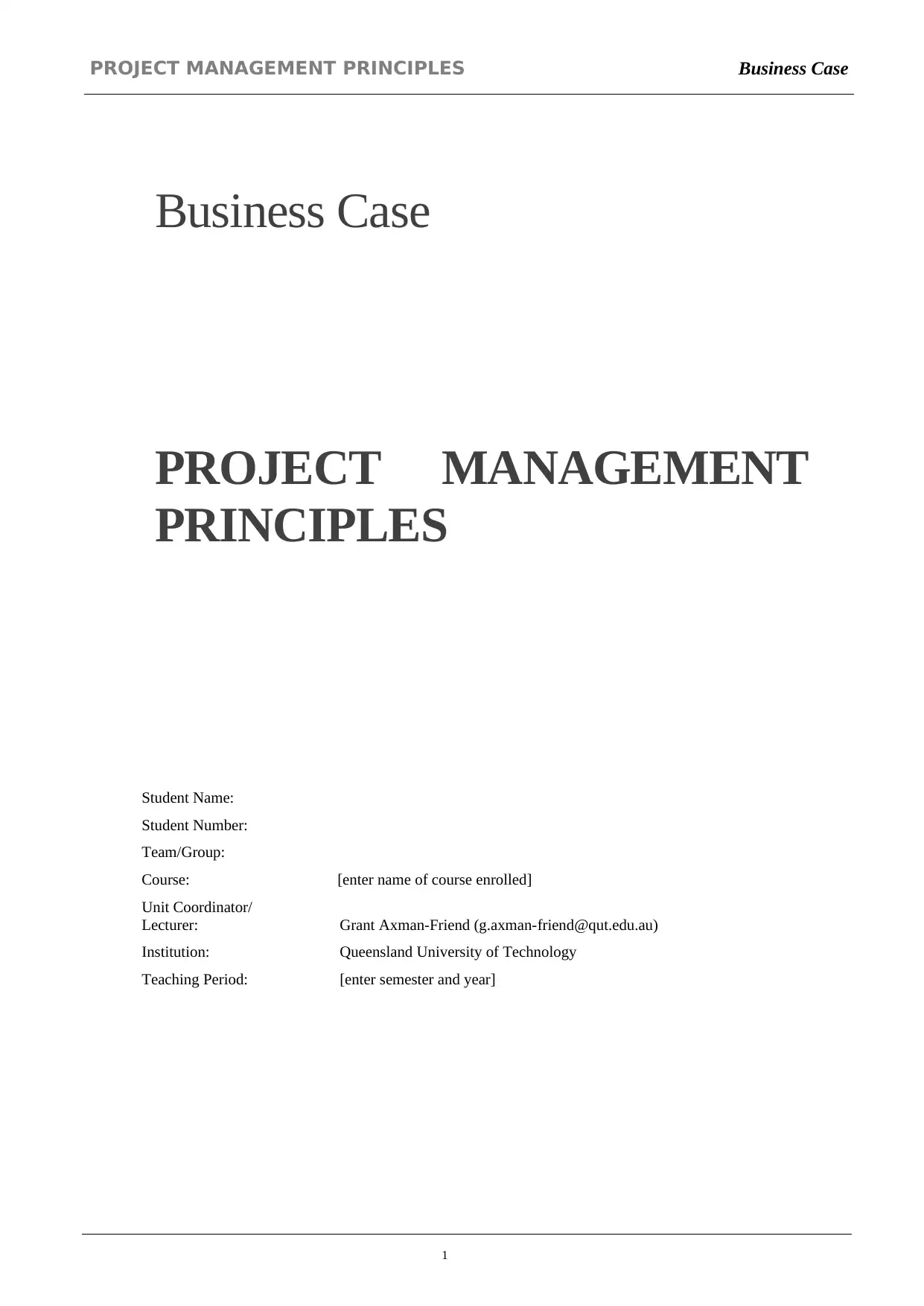
PROJECT MANAGEMENT PRINCIPLES Business Case
Business Case
PROJECT MANAGEMENT
PRINCIPLES
Student Name:
Student Number:
Team/Group:
Course: [enter name of course enrolled]
Unit Coordinator/
Lecturer: Grant Axman-Friend (g.axman-friend@qut.edu.au)
Institution: Queensland University of Technology
Teaching Period: [enter semester and year]
1
Business Case
PROJECT MANAGEMENT
PRINCIPLES
Student Name:
Student Number:
Team/Group:
Course: [enter name of course enrolled]
Unit Coordinator/
Lecturer: Grant Axman-Friend (g.axman-friend@qut.edu.au)
Institution: Queensland University of Technology
Teaching Period: [enter semester and year]
1
Paraphrase This Document
Need a fresh take? Get an instant paraphrase of this document with our AI Paraphraser
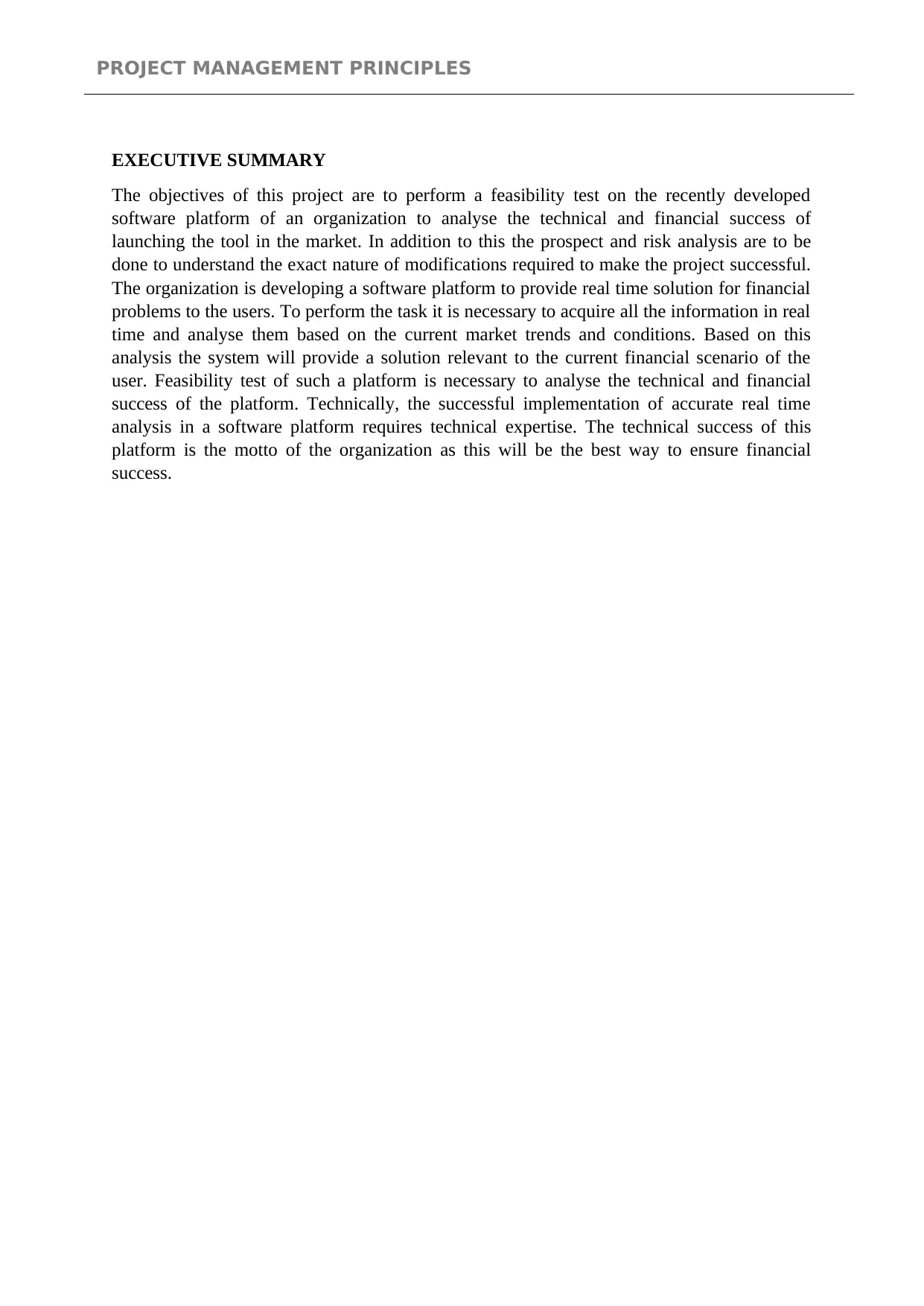
PROJECT MANAGEMENT PRINCIPLES
EXECUTIVE SUMMARY
The objectives of this project are to perform a feasibility test on the recently developed
software platform of an organization to analyse the technical and financial success of
launching the tool in the market. In addition to this the prospect and risk analysis are to be
done to understand the exact nature of modifications required to make the project successful.
The organization is developing a software platform to provide real time solution for financial
problems to the users. To perform the task it is necessary to acquire all the information in real
time and analyse them based on the current market trends and conditions. Based on this
analysis the system will provide a solution relevant to the current financial scenario of the
user. Feasibility test of such a platform is necessary to analyse the technical and financial
success of the platform. Technically, the successful implementation of accurate real time
analysis in a software platform requires technical expertise. The technical success of this
platform is the motto of the organization as this will be the best way to ensure financial
success.
EXECUTIVE SUMMARY
The objectives of this project are to perform a feasibility test on the recently developed
software platform of an organization to analyse the technical and financial success of
launching the tool in the market. In addition to this the prospect and risk analysis are to be
done to understand the exact nature of modifications required to make the project successful.
The organization is developing a software platform to provide real time solution for financial
problems to the users. To perform the task it is necessary to acquire all the information in real
time and analyse them based on the current market trends and conditions. Based on this
analysis the system will provide a solution relevant to the current financial scenario of the
user. Feasibility test of such a platform is necessary to analyse the technical and financial
success of the platform. Technically, the successful implementation of accurate real time
analysis in a software platform requires technical expertise. The technical success of this
platform is the motto of the organization as this will be the best way to ensure financial
success.
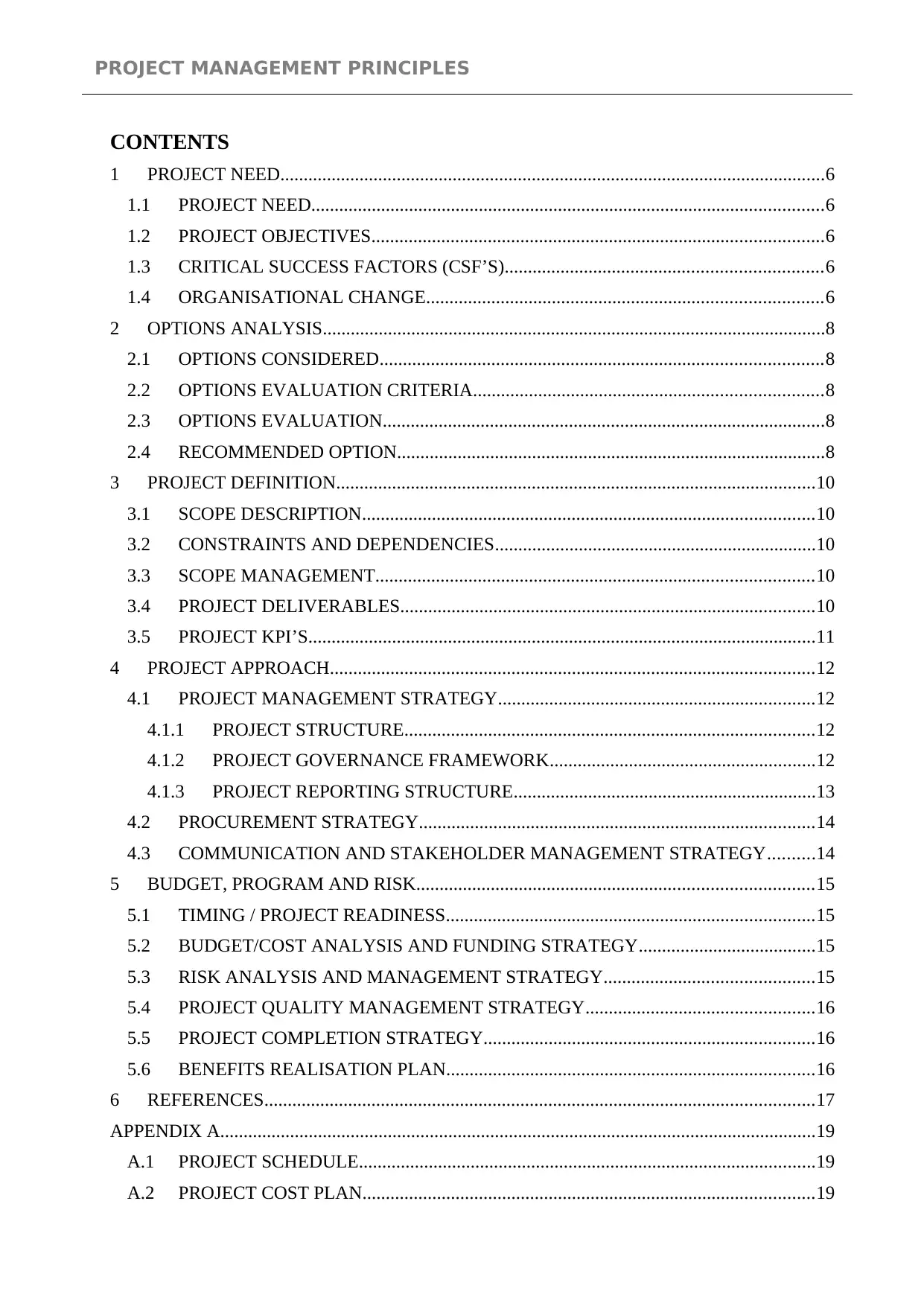
PROJECT MANAGEMENT PRINCIPLES
CONTENTS
1 PROJECT NEED.....................................................................................................................6
1.1 PROJECT NEED..............................................................................................................6
1.2 PROJECT OBJECTIVES.................................................................................................6
1.3 CRITICAL SUCCESS FACTORS (CSF’S)....................................................................6
1.4 ORGANISATIONAL CHANGE.....................................................................................6
2 OPTIONS ANALYSIS............................................................................................................8
2.1 OPTIONS CONSIDERED...............................................................................................8
2.2 OPTIONS EVALUATION CRITERIA...........................................................................8
2.3 OPTIONS EVALUATION...............................................................................................8
2.4 RECOMMENDED OPTION............................................................................................8
3 PROJECT DEFINITION.......................................................................................................10
3.1 SCOPE DESCRIPTION.................................................................................................10
3.2 CONSTRAINTS AND DEPENDENCIES.....................................................................10
3.3 SCOPE MANAGEMENT..............................................................................................10
3.4 PROJECT DELIVERABLES.........................................................................................10
3.5 PROJECT KPI’S.............................................................................................................11
4 PROJECT APPROACH........................................................................................................12
4.1 PROJECT MANAGEMENT STRATEGY....................................................................12
4.1.1 PROJECT STRUCTURE........................................................................................12
4.1.2 PROJECT GOVERNANCE FRAMEWORK.........................................................12
4.1.3 PROJECT REPORTING STRUCTURE.................................................................13
4.2 PROCUREMENT STRATEGY.....................................................................................14
4.3 COMMUNICATION AND STAKEHOLDER MANAGEMENT STRATEGY..........14
5 BUDGET, PROGRAM AND RISK.....................................................................................15
5.1 TIMING / PROJECT READINESS...............................................................................15
5.2 BUDGET/COST ANALYSIS AND FUNDING STRATEGY......................................15
5.3 RISK ANALYSIS AND MANAGEMENT STRATEGY.............................................15
5.4 PROJECT QUALITY MANAGEMENT STRATEGY.................................................16
5.5 PROJECT COMPLETION STRATEGY.......................................................................16
5.6 BENEFITS REALISATION PLAN...............................................................................16
6 REFERENCES......................................................................................................................17
APPENDIX A................................................................................................................................19
A.1 PROJECT SCHEDULE..................................................................................................19
A.2 PROJECT COST PLAN.................................................................................................19
CONTENTS
1 PROJECT NEED.....................................................................................................................6
1.1 PROJECT NEED..............................................................................................................6
1.2 PROJECT OBJECTIVES.................................................................................................6
1.3 CRITICAL SUCCESS FACTORS (CSF’S)....................................................................6
1.4 ORGANISATIONAL CHANGE.....................................................................................6
2 OPTIONS ANALYSIS............................................................................................................8
2.1 OPTIONS CONSIDERED...............................................................................................8
2.2 OPTIONS EVALUATION CRITERIA...........................................................................8
2.3 OPTIONS EVALUATION...............................................................................................8
2.4 RECOMMENDED OPTION............................................................................................8
3 PROJECT DEFINITION.......................................................................................................10
3.1 SCOPE DESCRIPTION.................................................................................................10
3.2 CONSTRAINTS AND DEPENDENCIES.....................................................................10
3.3 SCOPE MANAGEMENT..............................................................................................10
3.4 PROJECT DELIVERABLES.........................................................................................10
3.5 PROJECT KPI’S.............................................................................................................11
4 PROJECT APPROACH........................................................................................................12
4.1 PROJECT MANAGEMENT STRATEGY....................................................................12
4.1.1 PROJECT STRUCTURE........................................................................................12
4.1.2 PROJECT GOVERNANCE FRAMEWORK.........................................................12
4.1.3 PROJECT REPORTING STRUCTURE.................................................................13
4.2 PROCUREMENT STRATEGY.....................................................................................14
4.3 COMMUNICATION AND STAKEHOLDER MANAGEMENT STRATEGY..........14
5 BUDGET, PROGRAM AND RISK.....................................................................................15
5.1 TIMING / PROJECT READINESS...............................................................................15
5.2 BUDGET/COST ANALYSIS AND FUNDING STRATEGY......................................15
5.3 RISK ANALYSIS AND MANAGEMENT STRATEGY.............................................15
5.4 PROJECT QUALITY MANAGEMENT STRATEGY.................................................16
5.5 PROJECT COMPLETION STRATEGY.......................................................................16
5.6 BENEFITS REALISATION PLAN...............................................................................16
6 REFERENCES......................................................................................................................17
APPENDIX A................................................................................................................................19
A.1 PROJECT SCHEDULE..................................................................................................19
A.2 PROJECT COST PLAN.................................................................................................19
⊘ This is a preview!⊘
Do you want full access?
Subscribe today to unlock all pages.

Trusted by 1+ million students worldwide
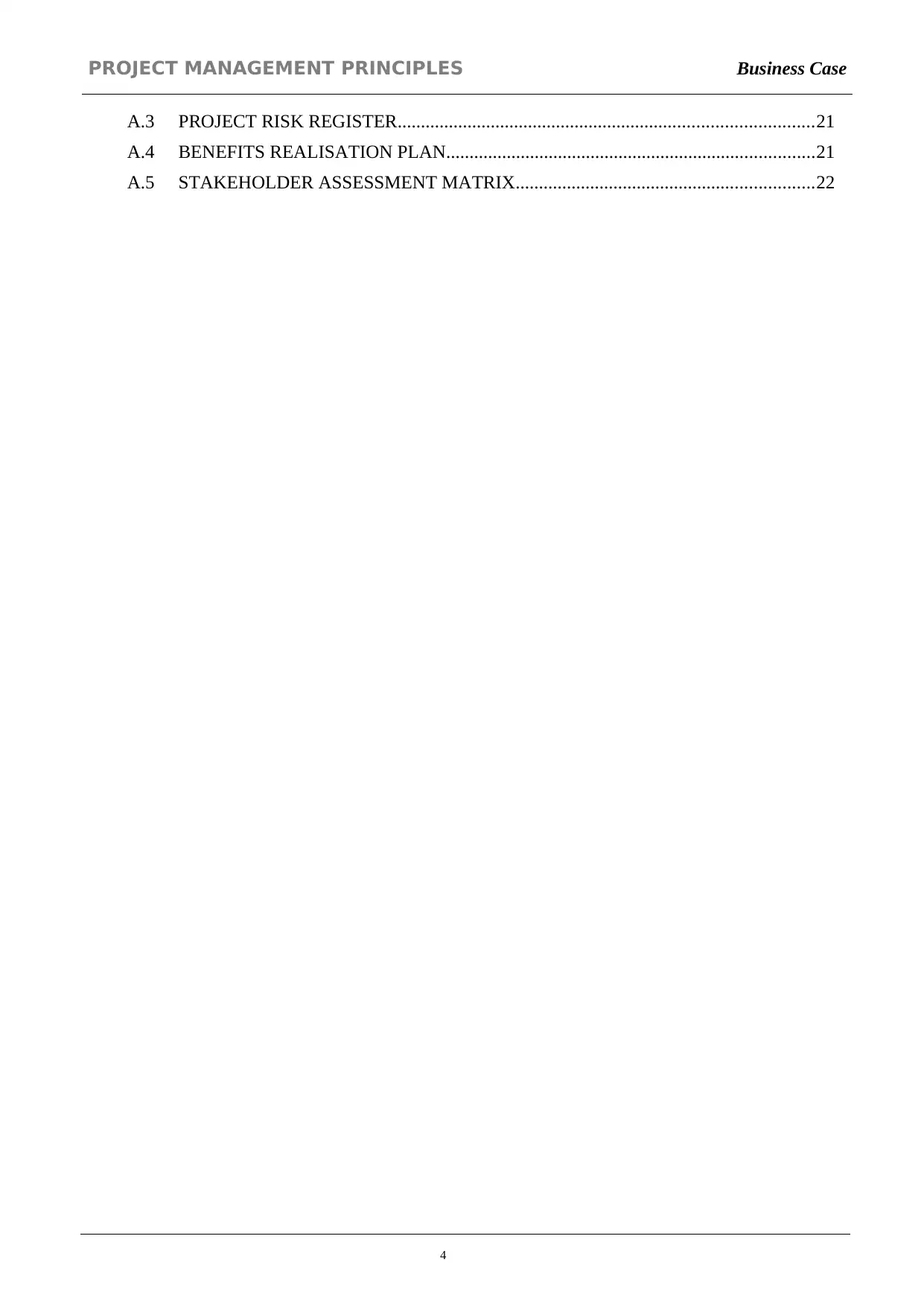
PROJECT MANAGEMENT PRINCIPLES Business Case
A.3 PROJECT RISK REGISTER.........................................................................................21
A.4 BENEFITS REALISATION PLAN...............................................................................21
A.5 STAKEHOLDER ASSESSMENT MATRIX................................................................22
4
A.3 PROJECT RISK REGISTER.........................................................................................21
A.4 BENEFITS REALISATION PLAN...............................................................................21
A.5 STAKEHOLDER ASSESSMENT MATRIX................................................................22
4
Paraphrase This Document
Need a fresh take? Get an instant paraphrase of this document with our AI Paraphraser

PROJECT MANAGEMENT PRINCIPLES Business Case
LIST OF TABLES
Table 2-1 | Project options...............................................................................................................7
Table 2-2 | Table 2 footer example – linked to contents.................................................................7
LIST OF FIGURES
No table of figures entries found.
5
LIST OF TABLES
Table 2-1 | Project options...............................................................................................................7
Table 2-2 | Table 2 footer example – linked to contents.................................................................7
LIST OF FIGURES
No table of figures entries found.
5
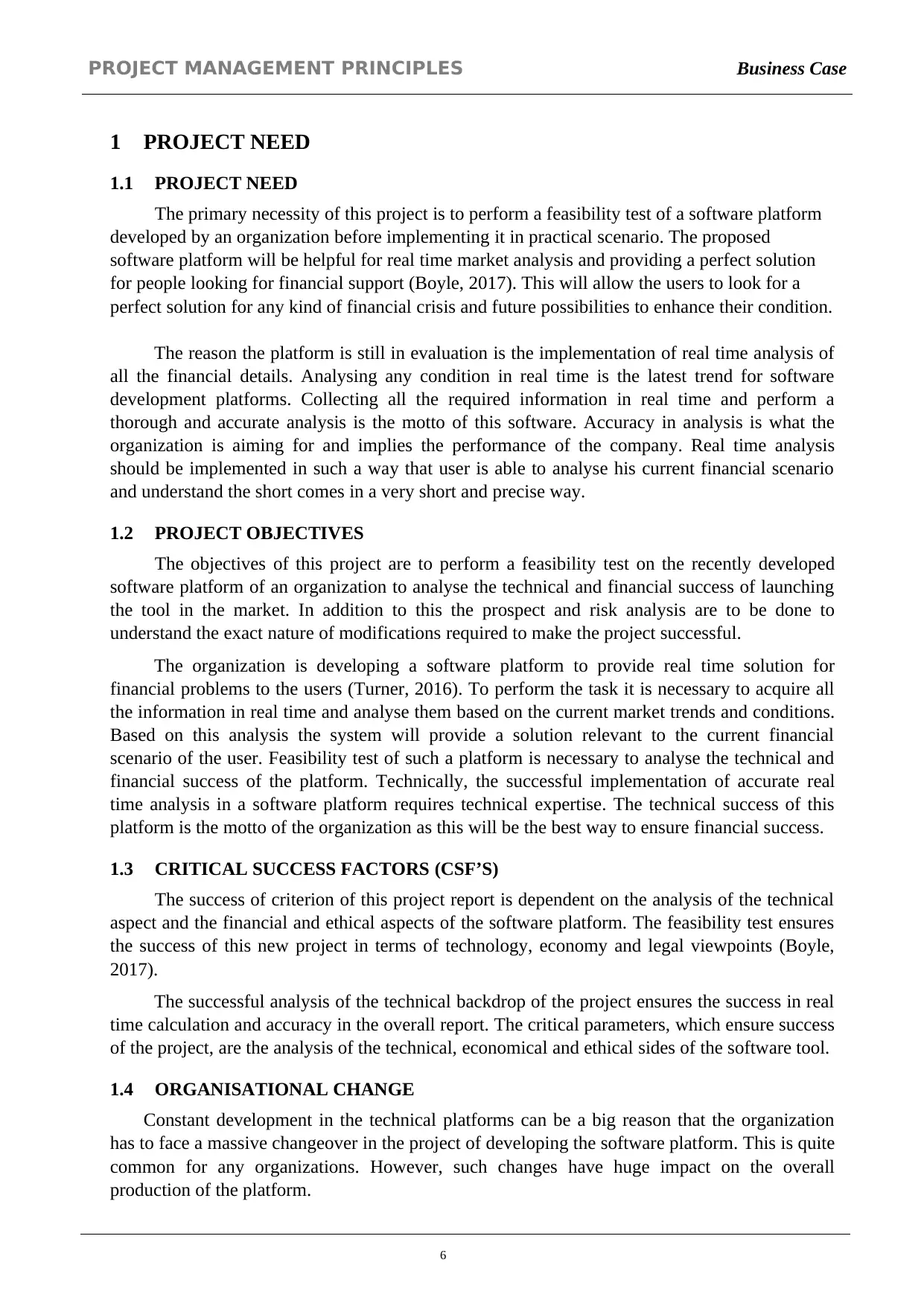
PROJECT MANAGEMENT PRINCIPLES Business Case
1 PROJECT NEED
1.1 PROJECT NEED
The primary necessity of this project is to perform a feasibility test of a software platform
developed by an organization before implementing it in practical scenario. The proposed
software platform will be helpful for real time market analysis and providing a perfect solution
for people looking for financial support (Boyle, 2017). This will allow the users to look for a
perfect solution for any kind of financial crisis and future possibilities to enhance their condition.
The reason the platform is still in evaluation is the implementation of real time analysis of
all the financial details. Analysing any condition in real time is the latest trend for software
development platforms. Collecting all the required information in real time and perform a
thorough and accurate analysis is the motto of this software. Accuracy in analysis is what the
organization is aiming for and implies the performance of the company. Real time analysis
should be implemented in such a way that user is able to analyse his current financial scenario
and understand the short comes in a very short and precise way.
1.2 PROJECT OBJECTIVES
The objectives of this project are to perform a feasibility test on the recently developed
software platform of an organization to analyse the technical and financial success of launching
the tool in the market. In addition to this the prospect and risk analysis are to be done to
understand the exact nature of modifications required to make the project successful.
The organization is developing a software platform to provide real time solution for
financial problems to the users (Turner, 2016). To perform the task it is necessary to acquire all
the information in real time and analyse them based on the current market trends and conditions.
Based on this analysis the system will provide a solution relevant to the current financial
scenario of the user. Feasibility test of such a platform is necessary to analyse the technical and
financial success of the platform. Technically, the successful implementation of accurate real
time analysis in a software platform requires technical expertise. The technical success of this
platform is the motto of the organization as this will be the best way to ensure financial success.
1.3 CRITICAL SUCCESS FACTORS (CSF’S)
The success of criterion of this project report is dependent on the analysis of the technical
aspect and the financial and ethical aspects of the software platform. The feasibility test ensures
the success of this new project in terms of technology, economy and legal viewpoints (Boyle,
2017).
The successful analysis of the technical backdrop of the project ensures the success in real
time calculation and accuracy in the overall report. The critical parameters, which ensure success
of the project, are the analysis of the technical, economical and ethical sides of the software tool.
1.4 ORGANISATIONAL CHANGE
Constant development in the technical platforms can be a big reason that the organization
has to face a massive changeover in the project of developing the software platform. This is quite
common for any organizations. However, such changes have huge impact on the overall
production of the platform.
6
1 PROJECT NEED
1.1 PROJECT NEED
The primary necessity of this project is to perform a feasibility test of a software platform
developed by an organization before implementing it in practical scenario. The proposed
software platform will be helpful for real time market analysis and providing a perfect solution
for people looking for financial support (Boyle, 2017). This will allow the users to look for a
perfect solution for any kind of financial crisis and future possibilities to enhance their condition.
The reason the platform is still in evaluation is the implementation of real time analysis of
all the financial details. Analysing any condition in real time is the latest trend for software
development platforms. Collecting all the required information in real time and perform a
thorough and accurate analysis is the motto of this software. Accuracy in analysis is what the
organization is aiming for and implies the performance of the company. Real time analysis
should be implemented in such a way that user is able to analyse his current financial scenario
and understand the short comes in a very short and precise way.
1.2 PROJECT OBJECTIVES
The objectives of this project are to perform a feasibility test on the recently developed
software platform of an organization to analyse the technical and financial success of launching
the tool in the market. In addition to this the prospect and risk analysis are to be done to
understand the exact nature of modifications required to make the project successful.
The organization is developing a software platform to provide real time solution for
financial problems to the users (Turner, 2016). To perform the task it is necessary to acquire all
the information in real time and analyse them based on the current market trends and conditions.
Based on this analysis the system will provide a solution relevant to the current financial
scenario of the user. Feasibility test of such a platform is necessary to analyse the technical and
financial success of the platform. Technically, the successful implementation of accurate real
time analysis in a software platform requires technical expertise. The technical success of this
platform is the motto of the organization as this will be the best way to ensure financial success.
1.3 CRITICAL SUCCESS FACTORS (CSF’S)
The success of criterion of this project report is dependent on the analysis of the technical
aspect and the financial and ethical aspects of the software platform. The feasibility test ensures
the success of this new project in terms of technology, economy and legal viewpoints (Boyle,
2017).
The successful analysis of the technical backdrop of the project ensures the success in real
time calculation and accuracy in the overall report. The critical parameters, which ensure success
of the project, are the analysis of the technical, economical and ethical sides of the software tool.
1.4 ORGANISATIONAL CHANGE
Constant development in the technical platforms can be a big reason that the organization
has to face a massive changeover in the project of developing the software platform. This is quite
common for any organizations. However, such changes have huge impact on the overall
production of the platform.
6
⊘ This is a preview!⊘
Do you want full access?
Subscribe today to unlock all pages.

Trusted by 1+ million students worldwide
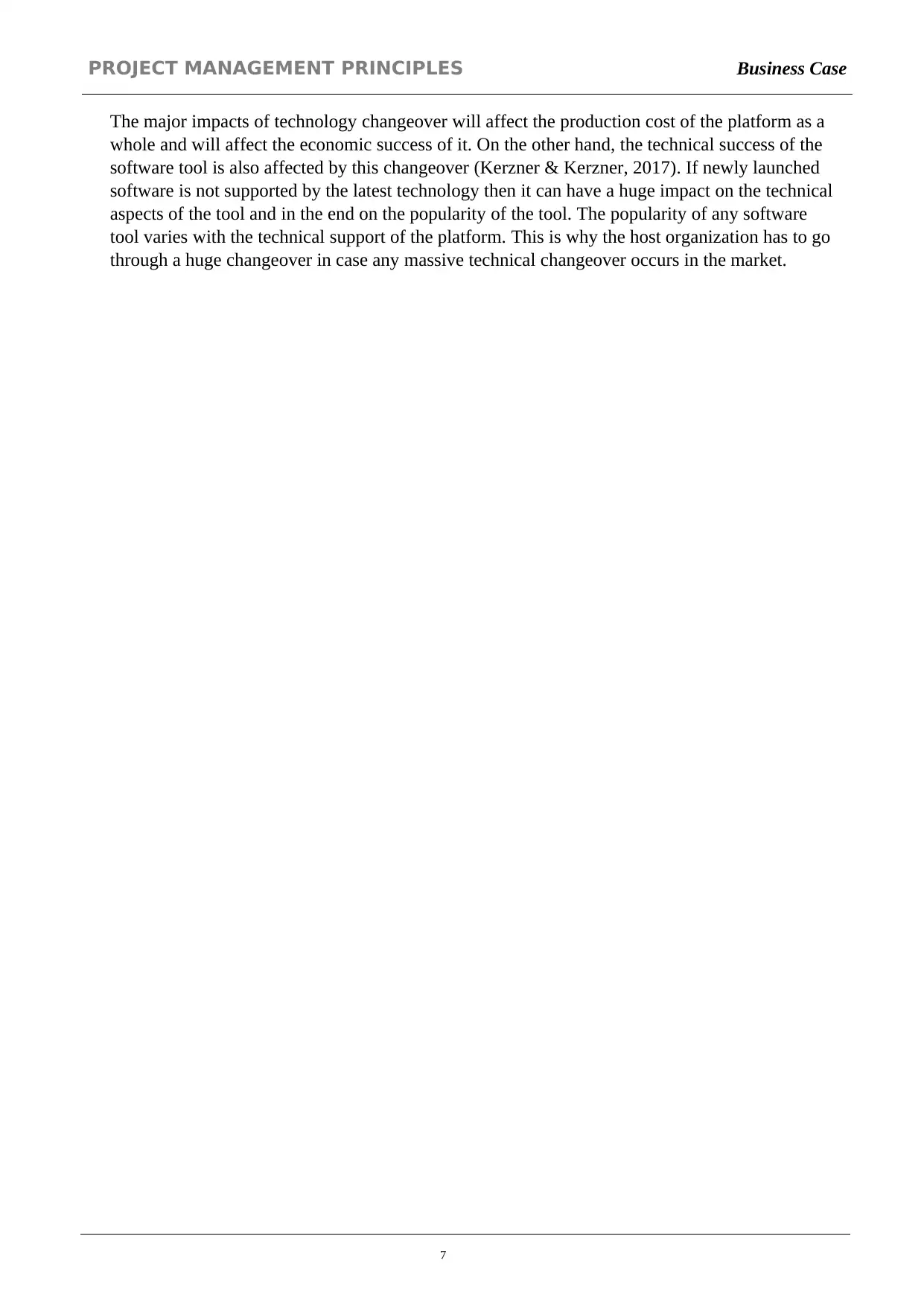
PROJECT MANAGEMENT PRINCIPLES Business Case
The major impacts of technology changeover will affect the production cost of the platform as a
whole and will affect the economic success of it. On the other hand, the technical success of the
software tool is also affected by this changeover (Kerzner & Kerzner, 2017). If newly launched
software is not supported by the latest technology then it can have a huge impact on the technical
aspects of the tool and in the end on the popularity of the tool. The popularity of any software
tool varies with the technical support of the platform. This is why the host organization has to go
through a huge changeover in case any massive technical changeover occurs in the market.
7
The major impacts of technology changeover will affect the production cost of the platform as a
whole and will affect the economic success of it. On the other hand, the technical success of the
software tool is also affected by this changeover (Kerzner & Kerzner, 2017). If newly launched
software is not supported by the latest technology then it can have a huge impact on the technical
aspects of the tool and in the end on the popularity of the tool. The popularity of any software
tool varies with the technical support of the platform. This is why the host organization has to go
through a huge changeover in case any massive technical changeover occurs in the market.
7
Paraphrase This Document
Need a fresh take? Get an instant paraphrase of this document with our AI Paraphraser
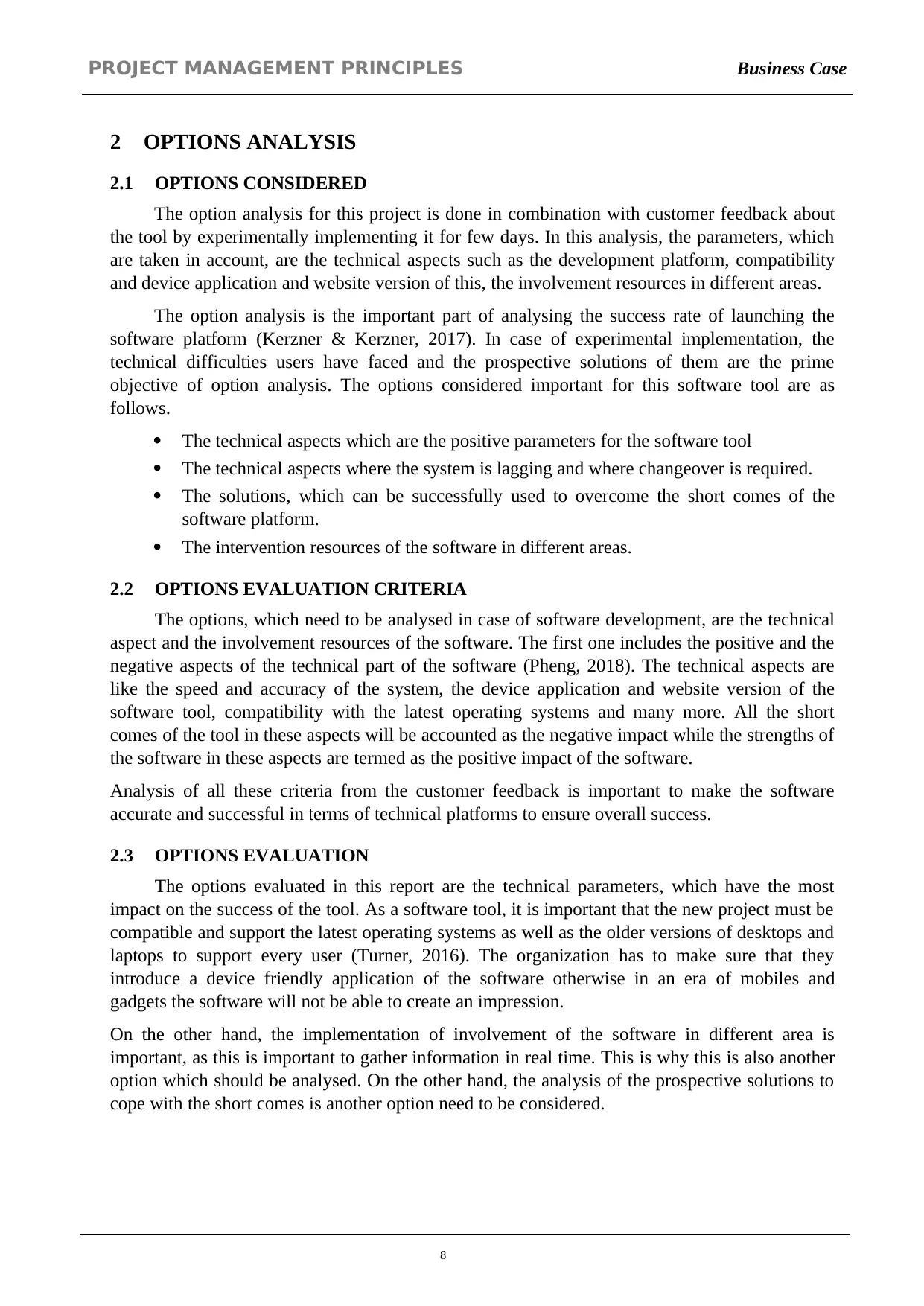
PROJECT MANAGEMENT PRINCIPLES Business Case
2 OPTIONS ANALYSIS
2.1 OPTIONS CONSIDERED
The option analysis for this project is done in combination with customer feedback about
the tool by experimentally implementing it for few days. In this analysis, the parameters, which
are taken in account, are the technical aspects such as the development platform, compatibility
and device application and website version of this, the involvement resources in different areas.
The option analysis is the important part of analysing the success rate of launching the
software platform (Kerzner & Kerzner, 2017). In case of experimental implementation, the
technical difficulties users have faced and the prospective solutions of them are the prime
objective of option analysis. The options considered important for this software tool are as
follows.
The technical aspects which are the positive parameters for the software tool
The technical aspects where the system is lagging and where changeover is required.
The solutions, which can be successfully used to overcome the short comes of the
software platform.
The intervention resources of the software in different areas.
2.2 OPTIONS EVALUATION CRITERIA
The options, which need to be analysed in case of software development, are the technical
aspect and the involvement resources of the software. The first one includes the positive and the
negative aspects of the technical part of the software (Pheng, 2018). The technical aspects are
like the speed and accuracy of the system, the device application and website version of the
software tool, compatibility with the latest operating systems and many more. All the short
comes of the tool in these aspects will be accounted as the negative impact while the strengths of
the software in these aspects are termed as the positive impact of the software.
Analysis of all these criteria from the customer feedback is important to make the software
accurate and successful in terms of technical platforms to ensure overall success.
2.3 OPTIONS EVALUATION
The options evaluated in this report are the technical parameters, which have the most
impact on the success of the tool. As a software tool, it is important that the new project must be
compatible and support the latest operating systems as well as the older versions of desktops and
laptops to support every user (Turner, 2016). The organization has to make sure that they
introduce a device friendly application of the software otherwise in an era of mobiles and
gadgets the software will not be able to create an impression.
On the other hand, the implementation of involvement of the software in different area is
important, as this is important to gather information in real time. This is why this is also another
option which should be analysed. On the other hand, the analysis of the prospective solutions to
cope with the short comes is another option need to be considered.
8
2 OPTIONS ANALYSIS
2.1 OPTIONS CONSIDERED
The option analysis for this project is done in combination with customer feedback about
the tool by experimentally implementing it for few days. In this analysis, the parameters, which
are taken in account, are the technical aspects such as the development platform, compatibility
and device application and website version of this, the involvement resources in different areas.
The option analysis is the important part of analysing the success rate of launching the
software platform (Kerzner & Kerzner, 2017). In case of experimental implementation, the
technical difficulties users have faced and the prospective solutions of them are the prime
objective of option analysis. The options considered important for this software tool are as
follows.
The technical aspects which are the positive parameters for the software tool
The technical aspects where the system is lagging and where changeover is required.
The solutions, which can be successfully used to overcome the short comes of the
software platform.
The intervention resources of the software in different areas.
2.2 OPTIONS EVALUATION CRITERIA
The options, which need to be analysed in case of software development, are the technical
aspect and the involvement resources of the software. The first one includes the positive and the
negative aspects of the technical part of the software (Pheng, 2018). The technical aspects are
like the speed and accuracy of the system, the device application and website version of the
software tool, compatibility with the latest operating systems and many more. All the short
comes of the tool in these aspects will be accounted as the negative impact while the strengths of
the software in these aspects are termed as the positive impact of the software.
Analysis of all these criteria from the customer feedback is important to make the software
accurate and successful in terms of technical platforms to ensure overall success.
2.3 OPTIONS EVALUATION
The options evaluated in this report are the technical parameters, which have the most
impact on the success of the tool. As a software tool, it is important that the new project must be
compatible and support the latest operating systems as well as the older versions of desktops and
laptops to support every user (Turner, 2016). The organization has to make sure that they
introduce a device friendly application of the software otherwise in an era of mobiles and
gadgets the software will not be able to create an impression.
On the other hand, the implementation of involvement of the software in different area is
important, as this is important to gather information in real time. This is why this is also another
option which should be analysed. On the other hand, the analysis of the prospective solutions to
cope with the short comes is another option need to be considered.
8
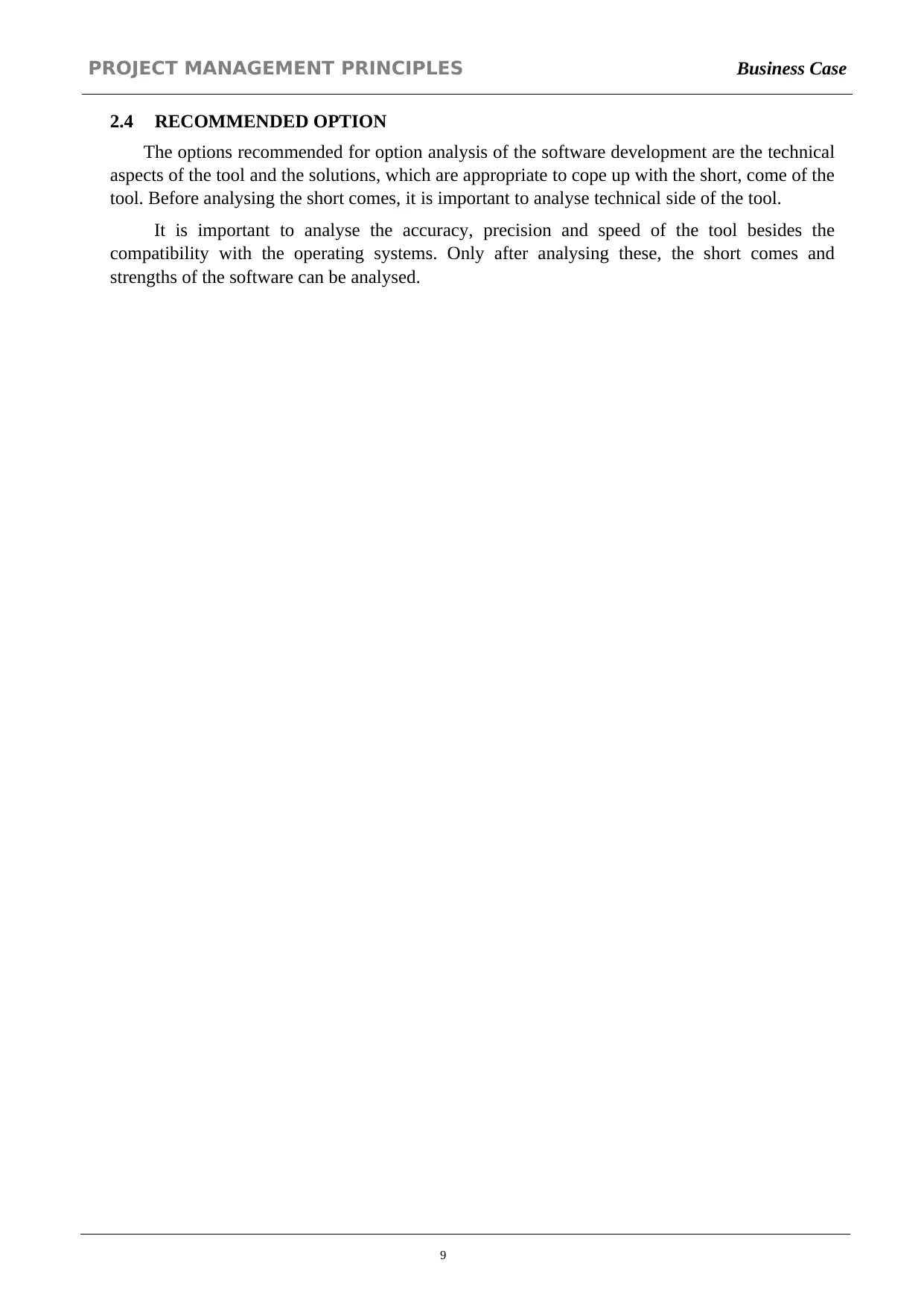
PROJECT MANAGEMENT PRINCIPLES Business Case
2.4 RECOMMENDED OPTION
The options recommended for option analysis of the software development are the technical
aspects of the tool and the solutions, which are appropriate to cope up with the short, come of the
tool. Before analysing the short comes, it is important to analyse technical side of the tool.
It is important to analyse the accuracy, precision and speed of the tool besides the
compatibility with the operating systems. Only after analysing these, the short comes and
strengths of the software can be analysed.
9
2.4 RECOMMENDED OPTION
The options recommended for option analysis of the software development are the technical
aspects of the tool and the solutions, which are appropriate to cope up with the short, come of the
tool. Before analysing the short comes, it is important to analyse technical side of the tool.
It is important to analyse the accuracy, precision and speed of the tool besides the
compatibility with the operating systems. Only after analysing these, the short comes and
strengths of the software can be analysed.
9
⊘ This is a preview!⊘
Do you want full access?
Subscribe today to unlock all pages.

Trusted by 1+ million students worldwide
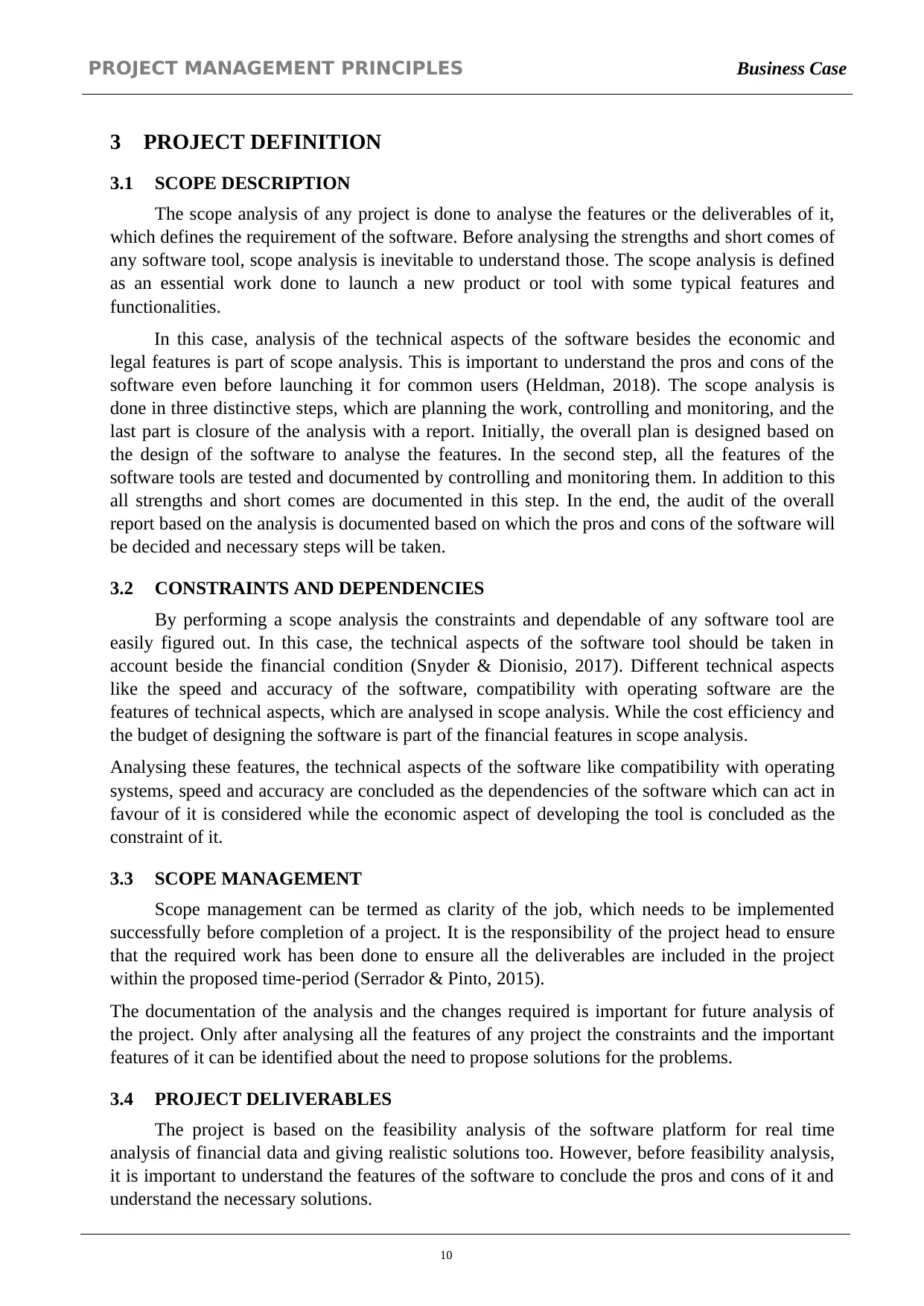
PROJECT MANAGEMENT PRINCIPLES Business Case
3 PROJECT DEFINITION
3.1 SCOPE DESCRIPTION
The scope analysis of any project is done to analyse the features or the deliverables of it,
which defines the requirement of the software. Before analysing the strengths and short comes of
any software tool, scope analysis is inevitable to understand those. The scope analysis is defined
as an essential work done to launch a new product or tool with some typical features and
functionalities.
In this case, analysis of the technical aspects of the software besides the economic and
legal features is part of scope analysis. This is important to understand the pros and cons of the
software even before launching it for common users (Heldman, 2018). The scope analysis is
done in three distinctive steps, which are planning the work, controlling and monitoring, and the
last part is closure of the analysis with a report. Initially, the overall plan is designed based on
the design of the software to analyse the features. In the second step, all the features of the
software tools are tested and documented by controlling and monitoring them. In addition to this
all strengths and short comes are documented in this step. In the end, the audit of the overall
report based on the analysis is documented based on which the pros and cons of the software will
be decided and necessary steps will be taken.
3.2 CONSTRAINTS AND DEPENDENCIES
By performing a scope analysis the constraints and dependable of any software tool are
easily figured out. In this case, the technical aspects of the software tool should be taken in
account beside the financial condition (Snyder & Dionisio, 2017). Different technical aspects
like the speed and accuracy of the software, compatibility with operating software are the
features of technical aspects, which are analysed in scope analysis. While the cost efficiency and
the budget of designing the software is part of the financial features in scope analysis.
Analysing these features, the technical aspects of the software like compatibility with operating
systems, speed and accuracy are concluded as the dependencies of the software which can act in
favour of it is considered while the economic aspect of developing the tool is concluded as the
constraint of it.
3.3 SCOPE MANAGEMENT
Scope management can be termed as clarity of the job, which needs to be implemented
successfully before completion of a project. It is the responsibility of the project head to ensure
that the required work has been done to ensure all the deliverables are included in the project
within the proposed time-period (Serrador & Pinto, 2015).
The documentation of the analysis and the changes required is important for future analysis of
the project. Only after analysing all the features of any project the constraints and the important
features of it can be identified about the need to propose solutions for the problems.
3.4 PROJECT DELIVERABLES
The project is based on the feasibility analysis of the software platform for real time
analysis of financial data and giving realistic solutions too. However, before feasibility analysis,
it is important to understand the features of the software to conclude the pros and cons of it and
understand the necessary solutions.
10
3 PROJECT DEFINITION
3.1 SCOPE DESCRIPTION
The scope analysis of any project is done to analyse the features or the deliverables of it,
which defines the requirement of the software. Before analysing the strengths and short comes of
any software tool, scope analysis is inevitable to understand those. The scope analysis is defined
as an essential work done to launch a new product or tool with some typical features and
functionalities.
In this case, analysis of the technical aspects of the software besides the economic and
legal features is part of scope analysis. This is important to understand the pros and cons of the
software even before launching it for common users (Heldman, 2018). The scope analysis is
done in three distinctive steps, which are planning the work, controlling and monitoring, and the
last part is closure of the analysis with a report. Initially, the overall plan is designed based on
the design of the software to analyse the features. In the second step, all the features of the
software tools are tested and documented by controlling and monitoring them. In addition to this
all strengths and short comes are documented in this step. In the end, the audit of the overall
report based on the analysis is documented based on which the pros and cons of the software will
be decided and necessary steps will be taken.
3.2 CONSTRAINTS AND DEPENDENCIES
By performing a scope analysis the constraints and dependable of any software tool are
easily figured out. In this case, the technical aspects of the software tool should be taken in
account beside the financial condition (Snyder & Dionisio, 2017). Different technical aspects
like the speed and accuracy of the software, compatibility with operating software are the
features of technical aspects, which are analysed in scope analysis. While the cost efficiency and
the budget of designing the software is part of the financial features in scope analysis.
Analysing these features, the technical aspects of the software like compatibility with operating
systems, speed and accuracy are concluded as the dependencies of the software which can act in
favour of it is considered while the economic aspect of developing the tool is concluded as the
constraint of it.
3.3 SCOPE MANAGEMENT
Scope management can be termed as clarity of the job, which needs to be implemented
successfully before completion of a project. It is the responsibility of the project head to ensure
that the required work has been done to ensure all the deliverables are included in the project
within the proposed time-period (Serrador & Pinto, 2015).
The documentation of the analysis and the changes required is important for future analysis of
the project. Only after analysing all the features of any project the constraints and the important
features of it can be identified about the need to propose solutions for the problems.
3.4 PROJECT DELIVERABLES
The project is based on the feasibility analysis of the software platform for real time
analysis of financial data and giving realistic solutions too. However, before feasibility analysis,
it is important to understand the features of the software to conclude the pros and cons of it and
understand the necessary solutions.
10
Paraphrase This Document
Need a fresh take? Get an instant paraphrase of this document with our AI Paraphraser
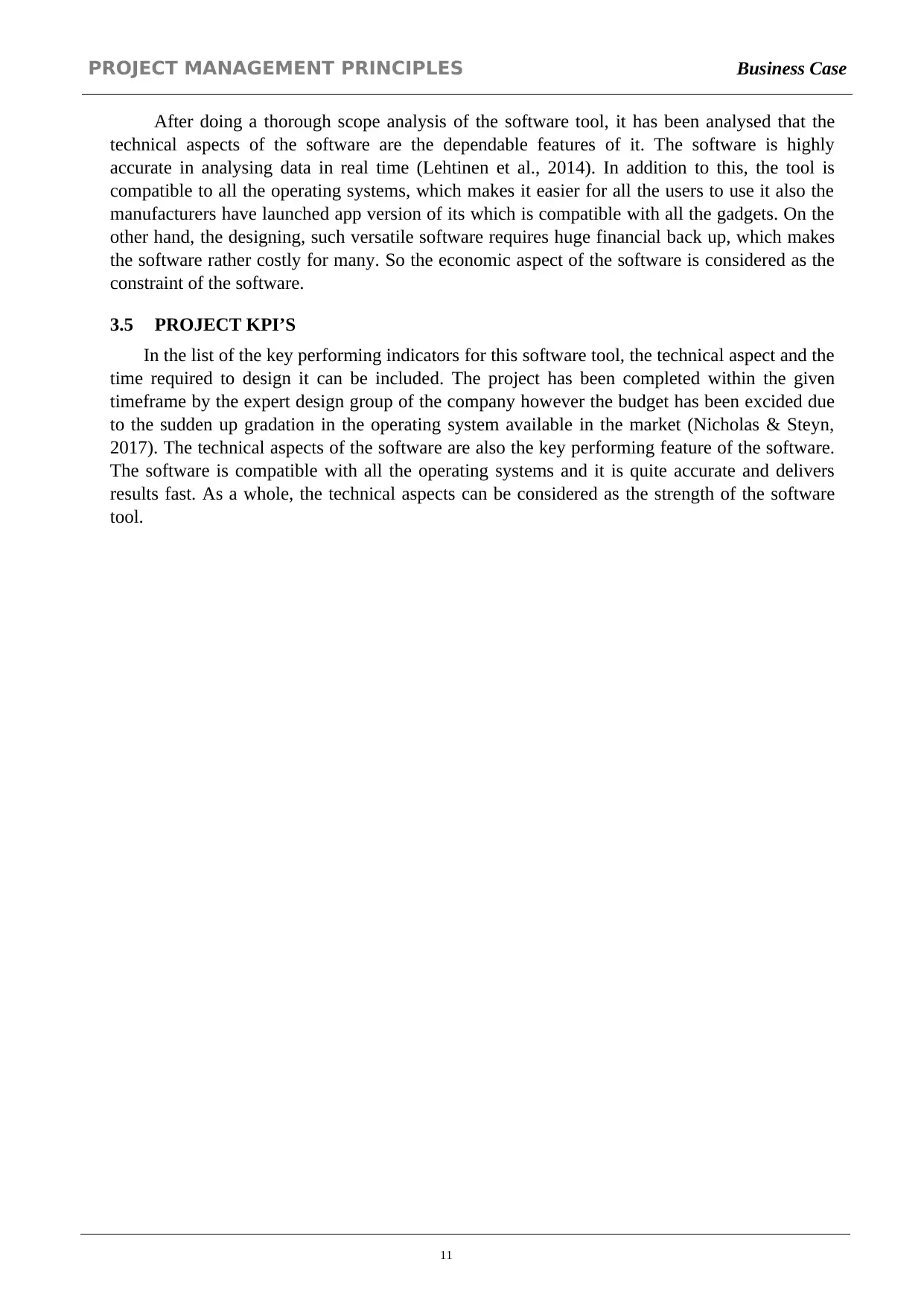
PROJECT MANAGEMENT PRINCIPLES Business Case
After doing a thorough scope analysis of the software tool, it has been analysed that the
technical aspects of the software are the dependable features of it. The software is highly
accurate in analysing data in real time (Lehtinen et al., 2014). In addition to this, the tool is
compatible to all the operating systems, which makes it easier for all the users to use it also the
manufacturers have launched app version of its which is compatible with all the gadgets. On the
other hand, the designing, such versatile software requires huge financial back up, which makes
the software rather costly for many. So the economic aspect of the software is considered as the
constraint of the software.
3.5 PROJECT KPI’S
In the list of the key performing indicators for this software tool, the technical aspect and the
time required to design it can be included. The project has been completed within the given
timeframe by the expert design group of the company however the budget has been excided due
to the sudden up gradation in the operating system available in the market (Nicholas & Steyn,
2017). The technical aspects of the software are also the key performing feature of the software.
The software is compatible with all the operating systems and it is quite accurate and delivers
results fast. As a whole, the technical aspects can be considered as the strength of the software
tool.
11
After doing a thorough scope analysis of the software tool, it has been analysed that the
technical aspects of the software are the dependable features of it. The software is highly
accurate in analysing data in real time (Lehtinen et al., 2014). In addition to this, the tool is
compatible to all the operating systems, which makes it easier for all the users to use it also the
manufacturers have launched app version of its which is compatible with all the gadgets. On the
other hand, the designing, such versatile software requires huge financial back up, which makes
the software rather costly for many. So the economic aspect of the software is considered as the
constraint of the software.
3.5 PROJECT KPI’S
In the list of the key performing indicators for this software tool, the technical aspect and the
time required to design it can be included. The project has been completed within the given
timeframe by the expert design group of the company however the budget has been excided due
to the sudden up gradation in the operating system available in the market (Nicholas & Steyn,
2017). The technical aspects of the software are also the key performing feature of the software.
The software is compatible with all the operating systems and it is quite accurate and delivers
results fast. As a whole, the technical aspects can be considered as the strength of the software
tool.
11
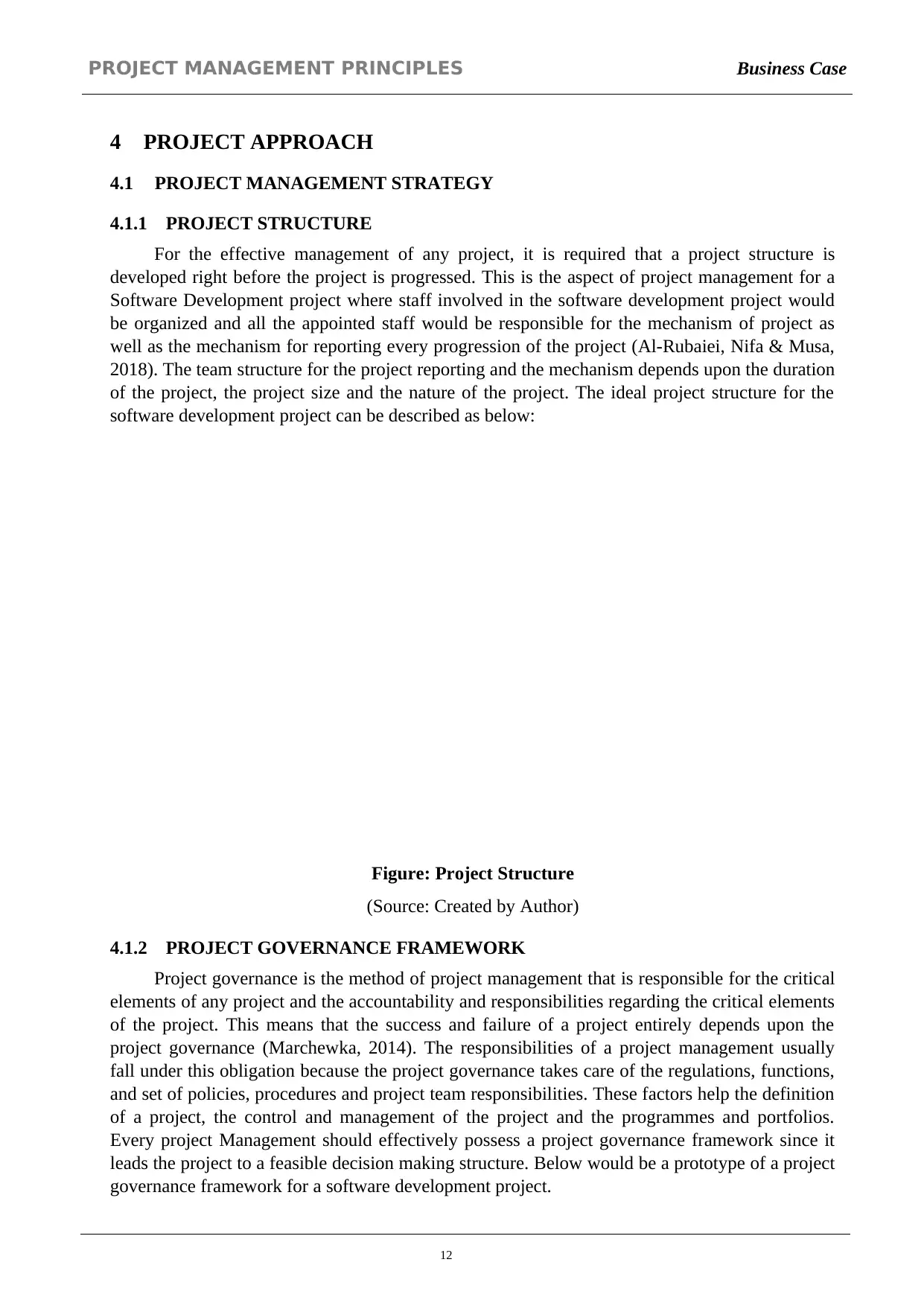
PROJECT MANAGEMENT PRINCIPLES Business Case
4 PROJECT APPROACH
4.1 PROJECT MANAGEMENT STRATEGY
4.1.1 PROJECT STRUCTURE
For the effective management of any project, it is required that a project structure is
developed right before the project is progressed. This is the aspect of project management for a
Software Development project where staff involved in the software development project would
be organized and all the appointed staff would be responsible for the mechanism of project as
well as the mechanism for reporting every progression of the project (Al-Rubaiei, Nifa & Musa,
2018). The team structure for the project reporting and the mechanism depends upon the duration
of the project, the project size and the nature of the project. The ideal project structure for the
software development project can be described as below:
Figure: Project Structure
(Source: Created by Author)
4.1.2 PROJECT GOVERNANCE FRAMEWORK
Project governance is the method of project management that is responsible for the critical
elements of any project and the accountability and responsibilities regarding the critical elements
of the project. This means that the success and failure of a project entirely depends upon the
project governance (Marchewka, 2014). The responsibilities of a project management usually
fall under this obligation because the project governance takes care of the regulations, functions,
and set of policies, procedures and project team responsibilities. These factors help the definition
of a project, the control and management of the project and the programmes and portfolios.
Every project Management should effectively possess a project governance framework since it
leads the project to a feasible decision making structure. Below would be a prototype of a project
governance framework for a software development project.
12
SoftwareDevelopmentProjectManagement
4 PROJECT APPROACH
4.1 PROJECT MANAGEMENT STRATEGY
4.1.1 PROJECT STRUCTURE
For the effective management of any project, it is required that a project structure is
developed right before the project is progressed. This is the aspect of project management for a
Software Development project where staff involved in the software development project would
be organized and all the appointed staff would be responsible for the mechanism of project as
well as the mechanism for reporting every progression of the project (Al-Rubaiei, Nifa & Musa,
2018). The team structure for the project reporting and the mechanism depends upon the duration
of the project, the project size and the nature of the project. The ideal project structure for the
software development project can be described as below:
Figure: Project Structure
(Source: Created by Author)
4.1.2 PROJECT GOVERNANCE FRAMEWORK
Project governance is the method of project management that is responsible for the critical
elements of any project and the accountability and responsibilities regarding the critical elements
of the project. This means that the success and failure of a project entirely depends upon the
project governance (Marchewka, 2014). The responsibilities of a project management usually
fall under this obligation because the project governance takes care of the regulations, functions,
and set of policies, procedures and project team responsibilities. These factors help the definition
of a project, the control and management of the project and the programmes and portfolios.
Every project Management should effectively possess a project governance framework since it
leads the project to a feasible decision making structure. Below would be a prototype of a project
governance framework for a software development project.
12
SoftwareDevelopmentProjectManagement
⊘ This is a preview!⊘
Do you want full access?
Subscribe today to unlock all pages.

Trusted by 1+ million students worldwide
1 out of 24
Related Documents
Your All-in-One AI-Powered Toolkit for Academic Success.
+13062052269
info@desklib.com
Available 24*7 on WhatsApp / Email
![[object Object]](/_next/static/media/star-bottom.7253800d.svg)
Unlock your academic potential
Copyright © 2020–2025 A2Z Services. All Rights Reserved. Developed and managed by ZUCOL.




